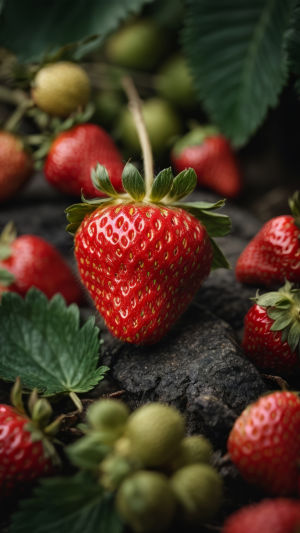Strawberries captivate with their heart-shaped appearance, vibrant red hue, and tender, juicy flesh, accompanied by a special rich fruit aroma.
Cultivating strawberries in greenhouses generally follows a facilitated or semi-facilitated mode, emphasizing varieties with easy dormancy breakage, robust disease resistance, and desirable characteristics.
<h3>Nursery Procedures:</h3>
(A) Nursery Time: The ideal time for mother planting typically falls in mid- to late March, ensuring completion before April.
(B) Nursery Preparation: Strawberries, with their shallow root system and strict soil, water, and fertilizer requirements, necessitate careful consideration during nursery preparation. Selecting level, fertile land with convenient water and drainage conditions is crucial, avoiding fields previously used for strawberry cultivation.
Deeply turning the soil before planting, incorporating 2000-3000 kg of well-rotted organic fertilizer and 50 kg of compound fertilizer per mu, and creating 1-meter-wide beds with 30 cm wide and 25 cm deep ditches are essential steps. Post-tillage, herbicide application and weed prevention using acetamiprid are recommended.
(C) Planting Methods: Choosing pest and disease-free mother plants is paramount. Strawberry detoxification seedlings or individually cultured mother plants are recommended. Planting in single rows with a spacing of 50-55 cm and around 800-1000 plants per acre ensures optimal growth.
Adhering to the principle of "deep not burying the heart, shallow not exposing the root" during planting is crucial. After planting, timely watering, covering the ridge with mulch for moisture retention, and warming are essential practices.
<h3>Seedling Management:</h3>
Rigorous weed control and timely removal of old, diseased, and dead leaves are imperative.
Vigilant plowing and soil loosening, along with timely removal of fruiting and flowering branches, contribute to healthy growth.
Maintaining soil moisture through controlled watering and avoiding large water irrigation is vital.
During the stolon sprouting season (May-July), 2-3 rounds of fertilizer application using compound fertilizer or urea (5-8 kg) promote robust seedling growth, with fertilizer application ceasing after July to ensure strong seedlings and encourage flower bud differentiation.
<h3>Harvesting Time:</h3>
Timely harvesting is pivotal for ensuring high-quality strawberry fruit. Typically, 30 days after flowering, around 120 days post-planting, the fruit attains a red hue, reaching maturity between 8-9.
Harvesting too early results in small nutrient accumulation, poor aroma, and low quality, while delaying harvest makes transportation difficult, and the fruit becomes prone to rot.
Strawberry harvesting should be strategically timed to avoid high-temperature stages, preventing softening and bruising leading to rot. The optimal harvesting window is before 11:00 a.m. or after 3:00 p.m., steering clear of dew-related issues during the process.
Mastering the art of cultivating strawberries involves meticulous nursery procedures, thoughtful seedling management, and precise harvesting practices. With attention to detail, growers can ensure a continuous supply of delightful, high-quality strawberries.





